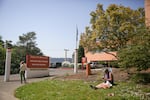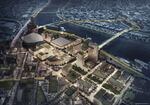The hottest piece of real estate in Portland is the big, brutalist monstrosity at 501 N. Dixon St. — the headquarters of Portland Public Schools.
The Blanchard Educational Service Center, home of Oregon's largest school district, is 360,000 square feet of offices, machine shops, kitchens and storage space for everything from fresh loaves of bread to damaged band instruments.
And it is not in great shape. In some spots, duct tape covers holes in the carpet. The temperature varies wildly from floor to floor and even room to room, symptoms of an aging HVAC system.
“This is not a building that we have maintained, and I think that sometimes that's difficult for employee morale, honestly,” said Sara King, the district’s head of planning and asset management.

File photo from April 26, 2018 of the Portland Public Schools administration building.
Abigail Winn / OPB
But as King notes, this place has one big thing going for it — the only thing that really matters in real estate: location.
“It’s 10 acres right next to downtown with terrific transportation access,” she said. “It is one of the great redevelopment sites in the city.”
That's why the organizers of the Portland Diamond Project, the group trying to bring Major League Baseball to Portland, made an offer on the property earlier this year: $80 million and help securing a new home for PPS.
It’s also why district officials didn’t seem worried when the baseball group pulled its offer last week, saying they'll have more news on where a stadium might go later this month. There are plenty of other ideas floating around out there for the PPS property — including the one baseball proponents now say they support.
Righting History’s Wrongs
Not so long ago, this stretch of Portland was a thriving commercial and residential hub — and the heart of African-American life in Oregon.
Urban renewal — the construction of the Rose Quarter and Memorial Coliseum, Interstate 5 and, yes, the Portland Public Schools headquarters — wiped that out. Many of the single-family homes in Albina were razed, and construction of I-5 destroyed the logical, walkable street grid that defines so much of inner Portland.
Michael Alexander is the former CEO of the Urban League of Portland and one of the leaders of a nonprofit called the Albina Vision Trust. He's from Brooklyn originally. When he talks about this part of Portland, he tells a story about taking his wife back to see the place he grew up a few years ago.
“Yes, the place has changed, but you can still see what it was," he said. “I go back, and I can see the place I grew up. These are brownstones, and they were built in the 1890s, and they’re still there. I can point to the house I was raised in. It’s very difficult to do that here.”

In the heart of the Albina district, the corner of North Williams and North Russell was once the center of a small yet thriving business district. These businesses were torn down in the early 1970s as part of large-scale urban renewal projects. Photo ca 1962.
The Oregon Historical Society. #bb009732
Today, a group of civic activists, architects and developers hope to recreate Albina for the 21st century by turning a big chunk of inner Northeast Portland into a pedestrian-friendly mix of offices, businesses and homes. Imagine the Pearl District built with the same attention to design and walkability, but with an emphasis on diversity and affordability.
Artist’s renderings created for the Albina Vision Trust show a neighborhood that is dense but built around mass transit, tailored for pedestrians and bikes and connected to the Willamette River. Organizers like to use the phrase “intentionally remarkable” for what they’re hoping to build.
“When we say ‘intentionally remarkable,’ what we mean is that we are trying to honor the past while creating something new, something that is very thoughtful on every level,” said Zari Santner, a former head of the Portland Parks Bureau and another Albina Vision organizer. “… There are folks, especially in the African-American community, who are a little bit skeptical because they keep saying, ‘We've been promised,’ but now they’re a little bit encouraged because they realize we are not government. We are just this group of people who came together, and we are not going to let go of this thing.”

An artist's rendering of the "Albina Vision" project in North Portland.
Hennebery Eddy Architects
The nonprofit already has significant political firepower, including Rukaiyah Adams, chief investment officer for the Meyer Memorial Trust. It's hard to imagine Major League Baseball proponents, who are currently trying to buy land for a stadium in the hope of someday luring an existing team or securing an expansion franchise, would have won a political fight against the Albina Vision team over the PPS property.
But to succeed, the Albina team needs a lot of money plus civic buy-in to do some pretty radical things — such as cover and build on top of portions of Interstate 5 as a way to stitch long-disconnected neighborhoods back together.
One more thing they probably need: That sweet and sizable piece of land PPS owns — and may not need much longer.
Education Changed, The Building Did Not
The school district’s current headquarters is more than twice the size of your average Costco and was built back when the myriad functions of a school district all had to take place in one spot.
Take food, for example.
“In the past, we used to do a lot of things ourselves. That made more financial sense,” said Claire Hertz, the district’s deputy superintendent for buildings and operations. “We baked our own bread. Now we buy bread made from a bakery and have it delivered. It’s just more cost effective that way.”
So district officials don’t need those huge, centralized kitchens. They don’t need warehouse space for hundreds of thousands of school supplies — you just buy those online as needed and have them shipped straight to individual campuses. They need plenty of offices and public meeting spaces, but maybe not all in one sought-after spot.
Related: PPS Clears The Air For New Middle School At Harriet Tubman Building
District leaders are currently paying an outside consulting firm as much as $150,000 to study their current space and help them figure out their best path forward. It is a complicated equation to solve.
“When you sell a building, like when you sell a house, sometimes all you care about often is what you received for the property,” said King, the district’s planning and real estate head. “But when you look at where you're going to be moving to, there are a lot of other considerations.”
School districts are traditionally reluctant to sell off real estate — once you sell a piece of land in a real-estate market such as Portland’s, it’s unlikely you’ll ever be able to afford to buy it back. The Blanchard building is bigger than the district needs, but there are also some basic school system functions that need to take place close to downtown and in a location that’s reasonably central to all their constituents.
The district also faces huge financial pressures. So ideally, if school officials do sell, they’d like to create a continuing revenue stream rather than just a one-time cash infusion. How to do that was easier to imagine with baseball, given all the parking and ticket fees teams and stadium owners can charge.

An artist's rendering of a reimagined Albina neighborhood in North Portland.
Hennebery Eddy Architects
District leaders say they are in no rush. They want — and need — to get this right.
“PPS has a history of short-term thinking about a lot of things, particularly properties,” board Chair Rita Moore told her colleagues at an October work session. “We want to make sure whatever we do with this property — or any property — is going to serve the district over the long haul, into the eons.”
And so, they weren’t all that disappointed when the Diamond Project rescinded its offer. That $80 million forced a conversation. Now district leaders think that if they do end up selling, their property, whatever its flaws, could be worth a lot more in both cash and community impact than the baseball team’s first pitch.